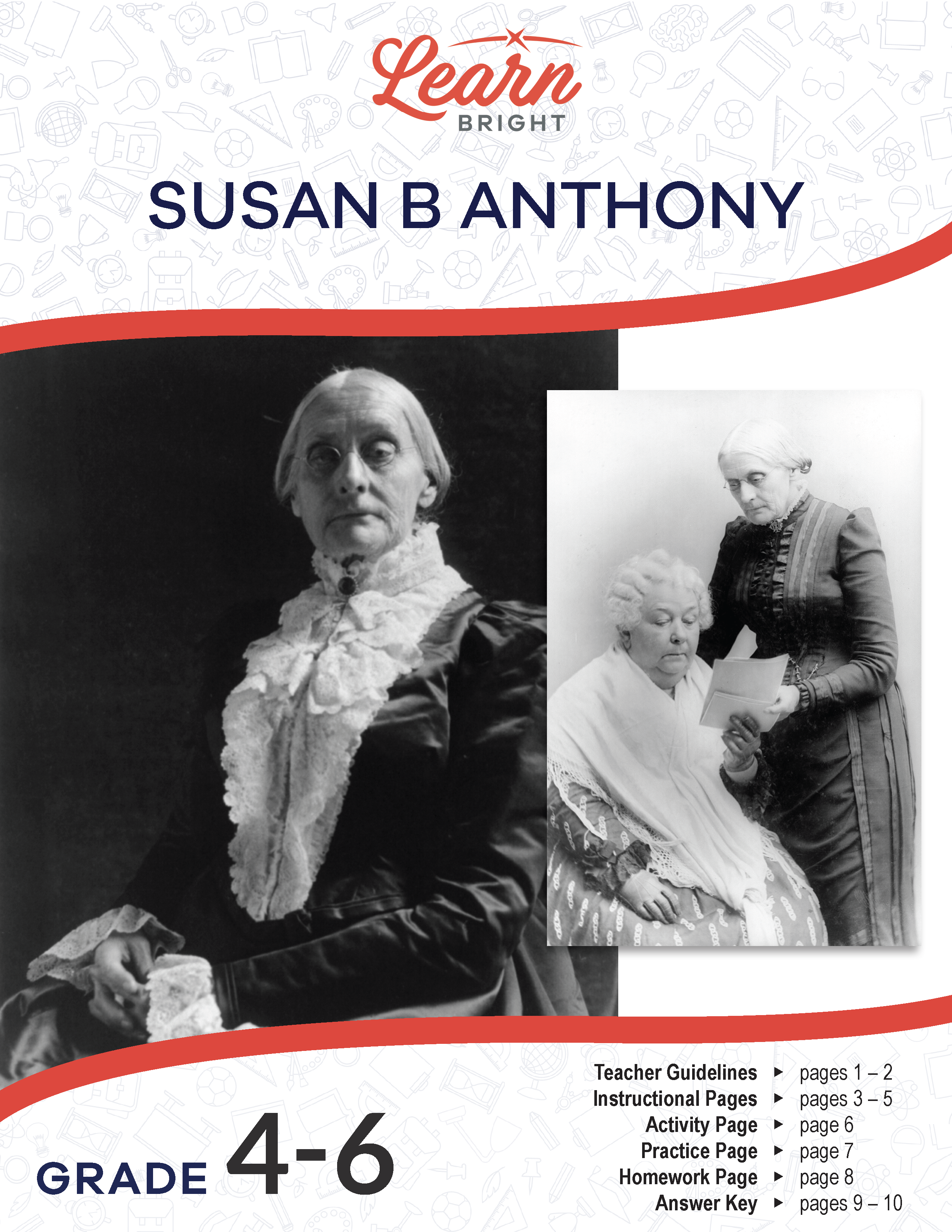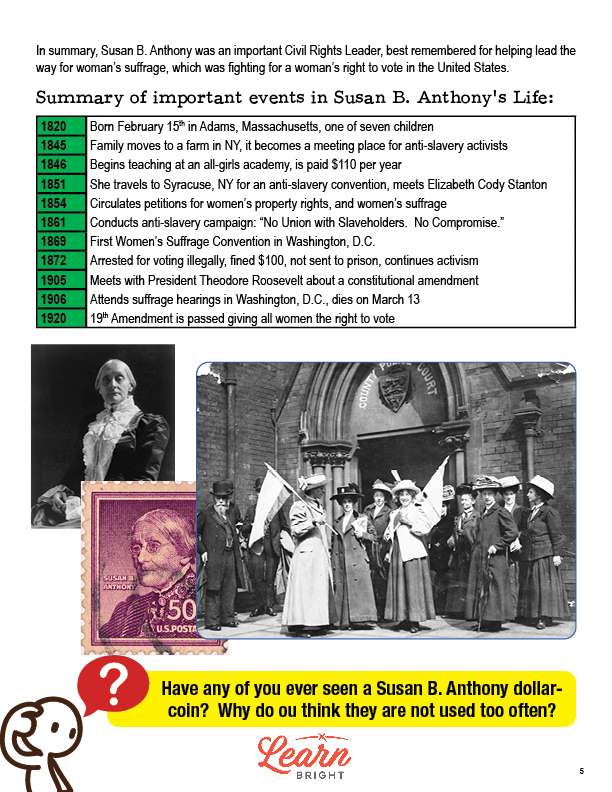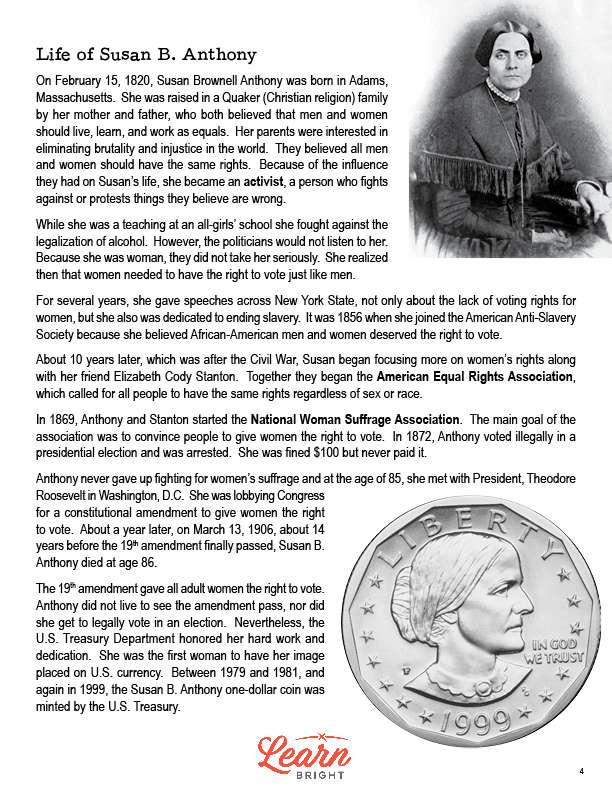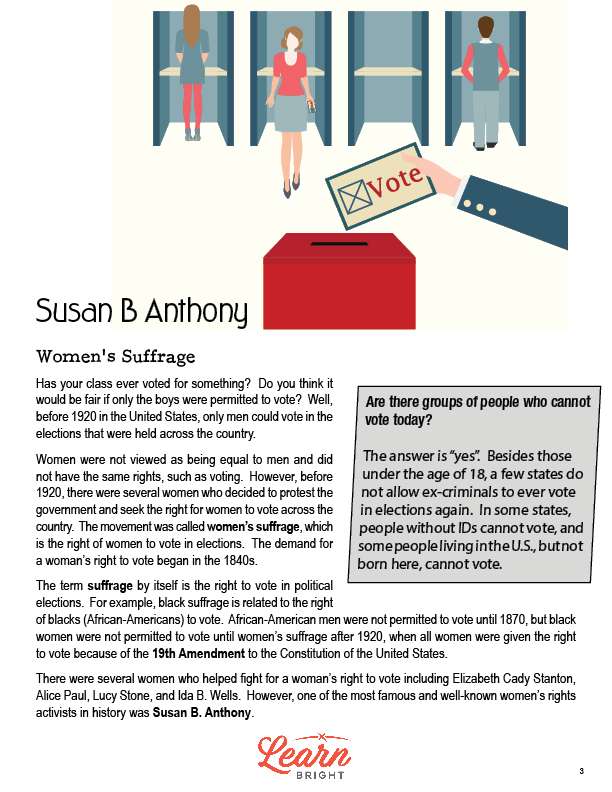Description
What our Susan B. Anthony lesson plan includes
Lesson Objectives and Overview: Susan B. Anthony introduces students to Susan B. Anthony. Most students may not have heard of Anthony and most are unlikely to be aware of her accomplishments related to women’s rights. The goal of the lesson is to help students become aware of Susan B. Anthony and the women’s suffrage movement during her lifetime. At the end of the lesson, students will be able to identify Susan B. Anthony, list facts about her life, and define women’s suffrage. This lesson is for students in 4th grade, 5th grade, and 6th grade.
Classroom Procedure
Every lesson plan provides you with a classroom procedure page that outlines a step-by-step guide to follow. You do not have to follow the guide exactly. The guide helps you organize the lesson and details when to hand out worksheets. It also lists information in the orange box that you might find useful. You will find the lesson objectives, state standards, and number of class sessions the lesson should take to complete in this area. In addition, it describes the supplies you will need as well as what and how you need to prepare beforehand. The supplies you will need for this lesson are construction paper or other paper for timelines, glue, markers, colored pencils, and the handouts.
Options for Lesson
Included with this lesson is an “Options for Lesson” section that lists a number of suggestions for activities to add to the lesson or substitutions for the ones already in the lesson. One optional addition to this lesson is to assign each student another woman who was involved in women’s suffrage and have them complete a report on her and present it to the class. You could celebrate Women’s History Month in March, studying a different woman from history each day for a week. You could also find a Susan B. Anthony coin to show to your students. If you have older students, you can lead a class discussion about why many people during that time did not want women to vote.
Teacher Notes
The teacher notes page includes a paragraph with additional guidelines and things to think about as you begin to plan your lesson. This page also includes lines that you can use to add your own notes as you’re preparing for this lesson.
SUSAN B. ANTHONY LESSON PLAN CONTENT PAGES
Women’s Suffrage
The Susan B. Anthony lesson plan includes three pages of content. The lesson begins by asking students whether they’ve ever voted for something as a class. What if only the boys in the class could vote? In the United States, before 1920, only men could vote in nationwide elections.
During this time, many men did not view women as equal to men. Women did not have equal rights. Before 1920, many women decided to protest this and seek the right to vote for women. They called this movement the women’s suffrage movement, which means the right of women to vote in elections. This movement began in the 1840s.
The word suffrage means the right to vote in political elections. Black suffrage, for example, is the right of Black people to to vote. Black men could not vote in the United States until 1870, and Black women could not vote until 1920, when they passed the 19th Amendment to the Constitution, giving all women the right to vote.
Many women fought for this right, including Elizabeth Cady Stanton, Alice Paul, Lucy Stone, and Ida B. Wells. A woman named Susan B. Anthony was one of the most well-known women’s rights activists.
Life of Susan B. Anthony
Susan Brownell Anthony was born in Adams, Massachusetts on February 15, 1820. Her parents raised her in a Quaker household, with the belief that men and women should live, learn, and work as equals. Her parents wanted to eliminate injustice from the world and they believed that men and women deserved the same rights. Susan became an activist because of their influence. An activist is a person who fights against things that they believe are wrong.
Susan taught at an all-girls’ school. During this time, she fought against the legalization of alcohol, though politicians did not listen to her. They did not take women seriously. She realized that women needed the right to vote to have a say in politics.
Susan spent several years giving speeches in New York State advocating for voting right for women and the end of slavery. She joined the American Anti-Slavery Society in 1856 because she believed Black men and women deserved the right to vote as well.
After the Civil War, she focused on women’s rights alongside Elizabeth Cady Stanton. They formed the American Equal Rights Association together. This organization called for all people to have the same rights regardless of sex or race.
Anthony and Stanton also started the National Woman Suffrage Association together in 1869. Their goal was to convince people that women should have the right to vote. The police arrested Anthony in 1872 when she voted illegally in a federal election. They fined her $100 (which she never paid).
Late Life and Legacy
Anthony kept fighting for women’s suffrage for her whole life. She met with President Theodore Roosevelt at the age of 85 while lobbying Congress for a constitutional amendment to give women the right to vote. Anthony died about a year later, on March 13, 1906. This was about 14 years before the passage of the 19th Amendment.
The 19th Amendment gave all adult women the right to vote. Anthony did not see the amendment pass and never voted legally. However, the U.S. Treasury Department decided to honor her work by making her the first women to have her image on U.S. currency. They minted the Susan B. Anthony one-dollar coin between 1979 and 1981 and again in 1999.
Susan B. Anthony was an important Civil Right leader who helped paved the way for women’s suffrage.
Summary of Important Events in Susan B. Anthony’s Life
The lesson ends with a list of some important events in Susan B. Anthony’s life.
In 1820, she was born on February 15th in Adams, Massachusetts, one of seven children. In 1845, her family moved to a farm in New York which became a meeting place for anti-slavery activists. Next, in 1846, she began teaching at an all-girls academy where they paid her $110 a year. In 1851, she met Elizabeth Cady Stanton at an anti-slavery convention in Syracuse, New York.
Next, in 1854, she circulated petitions for women’s property rights and women’s suffrage. In 1861, she conducted the “No Union with Slaveholders. No Compromise.” anti-slavery campaign. In 1869, they held the first Women’s Suffrage Convention in Washington, D.C. Then, in 1872, they arrested her for voting illegally and fined her $100; they did not send her to prison and she continued her activist work.
In 1905, she met with President Theodore Roosevelt about a constitutional amendment. In 1906, she attended suffrage hearings in Washington, D.C., and dies on March 13th. Finally, in 1920, they passed the 19th Amendment, giving all women the right to vote.
Key Terms
Here is a list of the vocabulary words students will learn in this lesson plan:
- Women’s suffrage: Right of women to vote in political elections
- Suffrage: The right to vote in political elections
- 19th Amendment: Gave women across the United States the right to vote
- Susan B. Anthony: Image appeared on a one-dollar coin
- Activist: Person who fights against things they feel is wrong
- American Equal Rights Association: Dedicated to both sexes and all races to having equal rights
- National Woman Suffrage Association: Dedicated to convincing people to give women voting rights
SUSAN B. ANTHONY LESSON PLAN WORKSHEETS
The Susan B. Anthony lesson plan includes three worksheets: an activity worksheet, a practice worksheet, and a homework assignment. You can refer to the guide on the classroom procedure page to determine when to hand out each worksheet.
TIMELINE ACTIVITY WORKSHEET
Students will work with a partner to complete the activity worksheet. Each pair will create a Susan B. Anthony Timeline using the events listed on the worksheet.
Students can also complete this activity on their own instead of with a partner.
MATCHING PRACTICE WORKSHEET
The practice worksheet asks students to first match ten terms and definitions. They will also answer 12 questions about the lesson material.
SUSAN B. ANTHONY HOMEWORK ASSIGNMENT
For the homework assignment, students will place ten events in Susan B. Anthony’s life in order from 1-10. They will also design the front of a coin and bill honoring two different women, one historical figure and one person from their life. They will include the value of the coin and bill, the person’s image, and other features seen on currency.
Worksheet Answer Keys
This lesson plan includes answer keys for the practice worksheet and the homework assignment. If you choose to administer the lesson pages to your students via PDF, you will need to save a new file that omits these pages. Otherwise, you can simply print out the applicable pages and keep these as reference for yourself when grading assignments.









